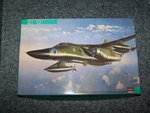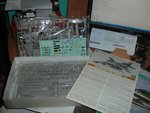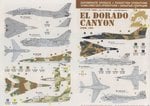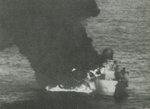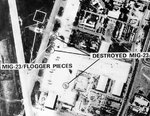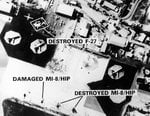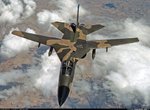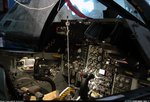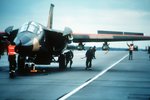kgambit
Tech Sergeant
Username: kgambit
Name: Dwight
Category 2 Intermediate
Model: F-111 F
Scale: 1:72
Manufacturer: Hasegawa
Aftermarket add ons:
- DP Caspar Decals - Operation El Dorado Canyon
- Verlinden Upgrade set (resin seats)
- Eduard PE set
- Hasegawa Weapons set IV (for the ALQ-131 ECM pod- center fuselage aft station)
- Hasegawa Weapons set VI (for the 4 GBU-10E Paveway IIs - wing pylons stations 3/6 and 4/5 - Note: The kit instructions has them mislabeled.)
Camo Scheme: As seen on the decals sheets:
- upper surfaces: dark green / green / brown (sand) - basically the SEA scheme;
------ Dark Green: FS34079 TAC Dark Green
------ Green: FS34102 TAC Green
------ Brown/sand: FS30219 TAC Tan
- underside surface and nose - flat black;
- cockpit: dark gull gray, FS 36231 (mixed with white for scale effect)
- wheel bays, gear and engine intakes - white;
- exposed internal portion of flaps - flat red
- GBU-10Es; main body is an Mk 84 - olive drab with yellow stripe - all but about the last 1/2" of the Mk 84 warhead's 3" yellow band is hidden by the guidance section's adapter collar; gas canister brown FS30117
The General Dynamics F-111 "Aardvark" or "Vark" is a medium-range interdictor and tactical strike aircraft that also fills the roles of strategic bomber, reconnaissance, and electronic warfare in its various versions. Developed in the 1960s and first entering service in 1967, the United States Air Force (USAF) variants were officially retired by 1998.
Although conceived as a multi-role fighter, the F-111 became a long-range attack aircraft primarily armed with air-to-surface ordnance, including a nuclear strike capability.
The F-111F was the final F-111 variant produced for Tactical Air Command, with a modern, but less expensive Mark IIB avionics system. The USAF approved development of the variant in 1969. It also included the more powerful TF30-P-100 engine and strengthened wing carry through box. A total of 106 were produced between 1970 and 1976.
In the early 1980s, the F-111F began to be equipped with the AVQ-26 Pave Tack forward looking infrared (FLIR) and laser designator system. Pave Tack system provided for the delivery of precision laser-guided munitions and mounted in the internal weapons bay. The Pacer Strike avionics update program replaced analog equipment with new digital equipment and multi-function displays
The F-111 F is probably best known for it's role in Operation El Dorado Canyon (otherwise known as the Raid on Libya) in April of 1986. Details on the Operation to follow.
Before I do a core dump on the Operation El Dorado Canyon, I need to get a definitive ruling on whether this qualifies for the Cold War GB or not. The particular markings I am using would have been in use back in the '70's and the "Vark" was definitely designed for a long range attack role, including tactical nukes, against WarPac. The only thing that might work against it is the timing of the particular operation and equipment employed during that op (the weapon load of GBU-10s and the Pave Tack pod are definitely late additions in the broad time frame). If this won't qualify, I'll find a suitable replacement.
Name: Dwight
Category 2 Intermediate
Model: F-111 F
Scale: 1:72
Manufacturer: Hasegawa
Aftermarket add ons:
- DP Caspar Decals - Operation El Dorado Canyon
- Verlinden Upgrade set (resin seats)
- Eduard PE set
- Hasegawa Weapons set IV (for the ALQ-131 ECM pod- center fuselage aft station)
- Hasegawa Weapons set VI (for the 4 GBU-10E Paveway IIs - wing pylons stations 3/6 and 4/5 - Note: The kit instructions has them mislabeled.)
Camo Scheme: As seen on the decals sheets:
- upper surfaces: dark green / green / brown (sand) - basically the SEA scheme;
------ Dark Green: FS34079 TAC Dark Green
------ Green: FS34102 TAC Green
------ Brown/sand: FS30219 TAC Tan
- underside surface and nose - flat black;
- cockpit: dark gull gray, FS 36231 (mixed with white for scale effect)
- wheel bays, gear and engine intakes - white;
- exposed internal portion of flaps - flat red
- GBU-10Es; main body is an Mk 84 - olive drab with yellow stripe - all but about the last 1/2" of the Mk 84 warhead's 3" yellow band is hidden by the guidance section's adapter collar; gas canister brown FS30117
The General Dynamics F-111 "Aardvark" or "Vark" is a medium-range interdictor and tactical strike aircraft that also fills the roles of strategic bomber, reconnaissance, and electronic warfare in its various versions. Developed in the 1960s and first entering service in 1967, the United States Air Force (USAF) variants were officially retired by 1998.
Although conceived as a multi-role fighter, the F-111 became a long-range attack aircraft primarily armed with air-to-surface ordnance, including a nuclear strike capability.
The F-111F was the final F-111 variant produced for Tactical Air Command, with a modern, but less expensive Mark IIB avionics system. The USAF approved development of the variant in 1969. It also included the more powerful TF30-P-100 engine and strengthened wing carry through box. A total of 106 were produced between 1970 and 1976.
In the early 1980s, the F-111F began to be equipped with the AVQ-26 Pave Tack forward looking infrared (FLIR) and laser designator system. Pave Tack system provided for the delivery of precision laser-guided munitions and mounted in the internal weapons bay. The Pacer Strike avionics update program replaced analog equipment with new digital equipment and multi-function displays
The F-111 F is probably best known for it's role in Operation El Dorado Canyon (otherwise known as the Raid on Libya) in April of 1986. Details on the Operation to follow.
Before I do a core dump on the Operation El Dorado Canyon, I need to get a definitive ruling on whether this qualifies for the Cold War GB or not. The particular markings I am using would have been in use back in the '70's and the "Vark" was definitely designed for a long range attack role, including tactical nukes, against WarPac. The only thing that might work against it is the timing of the particular operation and equipment employed during that op (the weapon load of GBU-10s and the Pave Tack pod are definitely late additions in the broad time frame). If this won't qualify, I'll find a suitable replacement.
Attachments
Last edited:

